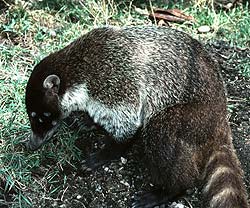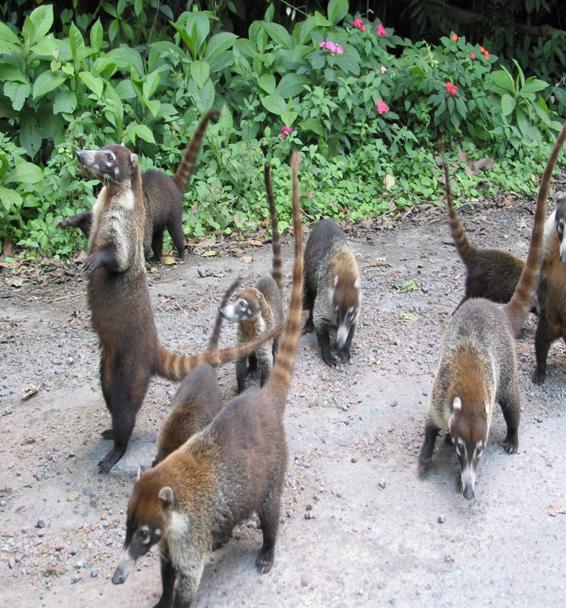January 19, 2008
Alux hominids are Proto-Pygmies. The Aluxob (plural Maya) are seen in the Yucatan, Mexico, mostly by the Mayans, but sometimes by Mexicans and United States tourists, quite regularly.
People in the Yucatan see the Aluxob, and when I was there in the 1980s, I was able to interview informants (mostly Mayans) who had firsthand sightings. In my 1985 book, Curious Encounters, I devoted a chapter to the lore, legends, and legacy of these Little People in that corner of the world.
Things do not seem to have changed there.
In one recent case, Dan Gannon, the moderator of an anthropological e-group, has today shared the following sighting, which occurred while he was on vacation in the Yucatan:
Regarding what I saw (glimpsed) that looked like an Alux tiny hominid, I’ll briefly describe it, and the circumstances:
From the note I jotted down right after the sighting: It was 8:55 PM local time, and the date was 12-30-2007 (December 30, 2007).
A couple hours after sunset, I was in a vehicle (with my wife, and a couple of her family members, including one of her brothers, who was driving) traveling from Merida, Yucatan, to Oxkutzcab, Yucatan. I was in the front-right passenger seat. A light rain had just ended (the first rain I’d seen in Yucatan, implying that it may have been the first rain in that part of Yucatan, in at least two weeks).
As can be observed elsewhere, the first rain after a dry spell tends to correlate with increased animal movement, and I saw a bunch of animals in the vehicle’s headlights, as we travelled. You can always see a lot of spiders, lizards and snakes on these rural roads (their eyes reflect in the headlights, similar to a cat’s eyes, something one of my wife Elsa’s brothers pointed out to me, and I can attest to) as well as an occasional dog (the dogs tend to cluster around towns and villages). But I saw my first raccoon in Yucatan, during that drive, and about two minutes later, I saw something I wasn’t expecting.
On the same side of the road on which I saw the raccoon, (on my right) I saw what looked like a human shoulder and arm, and a leg beneath it. It appeared to be a hominid, about 2′ tall, facing the direction of the vehicle, mostly obscured behind a clump of tall (about 3′ tall) dried weeds, with only the right side of the body just showing in the headlights. Skin color was medium brown, about the same color as our driver’s skin, not the dark brown skin of many Mayans that work outside, in the direct sunlight during the daytime, but lighter (so I say “medium brown”). What I saw was not indicative of a thin, scrawny hominid, but rather a very, very muscular one.
As the vehicle drew closer and passed the apparent hominid, I could see without a doubt that it moved, in a side-stepping motion away from the lights of the vehicle, to more completely hide itself behind the clump of tall weeds. I could also see that the features were very human-like, and not hairy at all (just as the typical Mayan has no visible hair, for instance on the face, arms, and chest, so appeared this hominid).
I have a good idea of how high the shoulder was, because I could compare it to the regular posts (made of concrete?) that appear on the sides of that road, at regular intervals. The posts are about 1.5′ to 2′ high, I’d guess, and the shoulder was about the same height, possibly a little higher. The apparent hominid definitely wasn’t a post (not only was it positioned wrong, but it looked and behaved wrong, to be a post.) I mean, posts don’t visibly move of their own accord, and don’t look like that. As I was the only one intently gazing in the right direction at the right time (I was constantly and deliberately observing all sorts of plants, animals, stones, etc.) I was, unfortunately, the only one that caught a glimpse of it.
After a few seconds of speechless amazement, I blurted out what I had seen. Unfortunately, our driver didn’t stop or even slow down (Mayans actually try to avoid Aluxob, it seems, possibly for the same reasons that Africans avoid the similar hominids they call Tokaloshes: fear, including stories of people who apparently were killed by the Aluxob, after encroaching into their territory and/or caves).
I made a point of asking our driver to make a note of exactly where we were, when I saw this apparent hominid. Later that night, after we returned to Elsa’s parents’ house, I told other family members of what I saw. Our driver (Elsa’s oldest brother) also described exactly where we were. Elsa’s father said we were in the middle of a specific forested area (“selva,” he called it, which I think means something like “wilds” or “forest,”) where Aluxob are often reported. I’m quite encouraged by all of this. You can bet I’ll be bringing trail cameras on my next visit.Dan Gannon
I appreciate Dan Gannon’s sharing of his sighting, for it gives a good view of how quickly these accounts occur.
Besides the obvious intrigueness of the Alux, small human or child encounter of Gannon’s, I was curious about his sighting of a “raccoon” in conjunction with this report too.
The Cozumel Raccoon (Procyon pygmaeus), a small, dwarf form of raccoon is known from the island of Cozumel, but not from the Yucatan mainland proper. The Raccoon or Common Raccoon (Procyon lotor), while known from central Mexico, in general, is not reported to be part of the wildlife of the Yucatan. What was Gannon’s Yucatan “raccoon”?
Perhaps what was seen was a White Nosed Coatimundi (Nasua narica), which has a slightly ringed tail and a stronger mask than the Cacomistle (Bassariscus sumichrasti)? The White Nosed Coatis (all three images here are of them) do have a natural range that exists in the Yucatan.

The Ring-tailed Coati (Nasua nasua) are not reported from the Yucatan, and neither are the Cacomistle, which are very rare, even though they do have a large ringed tail and are found in southern Mexico (but supposedly not in the Yucatan).

About Loren Coleman
Loren Coleman is one of the world’s leading cryptozoologists, some say “the” leading living cryptozoologist. Certainly, he is acknowledged as the current living American researcher and writer who has most popularized cryptozoology in the late 20th and early 21st centuries.
Starting his fieldwork and investigations in 1960, after traveling and trekking extensively in pursuit of cryptozoological mysteries, Coleman began writing to share his experiences in 1969. An honorary member of Ivan T. Sanderson’s Society for the Investigation of the Unexplained in the 1970s, Coleman has been bestowed with similar honorary memberships of the North Idaho College Cryptozoology Club in 1983, and in subsequent years, that of the British Columbia Scientific Cryptozoology Club, CryptoSafari International, and other international organizations. He was also a Life Member and Benefactor of the International Society of Cryptozoology (now-defunct).
Loren Coleman’s daily blog, as a member of the Cryptomundo Team, served as an ongoing avenue of communication for the ever-growing body of cryptozoo news from 2005 through 2013. He returned as an infrequent contributor beginning Halloween week of 2015.
Coleman is the founder in 2003, and current director of the International Cryptozoology Museum in Portland, Maine.
Filed under Breaking News, Cryptomundo Exclusive, Cryptotourism, CryptoZoo News, Cryptozoologists, Cryptozoology, Eyewitness Accounts, Folklore, Homo floresiensis